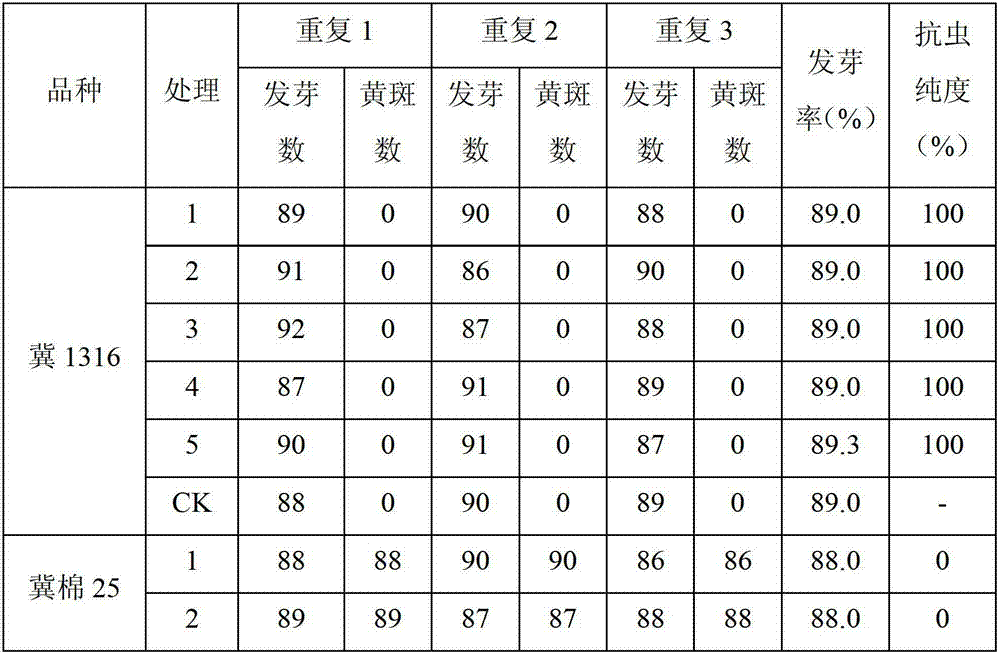Method for simultaneously detecting emergence rate and insect resistance purity of transgenic Bt insect-resistant cottonseeds
A technology of germination rate and insect resistance, which is applied in the field of transgenic plant detection to achieve the effects of low cost, simple operation and simple equipment
- Summary
- Abstract
- Description
- Claims
- Application Information
AI Technical Summary
Problems solved by technology
Method used
Image
Examples
Embodiment 1
[0018] Example 1: Spray 0.4% kanamycin sulfate aqueous solution to measure the germination rate of transgenic Bt gene insect-resistant cotton seeds while measuring insect-resistant purity
[0019] 1. Preparation of 0.4% kanamycin sulfate aqueous solution: weigh 4 g of kanamycin sulfate powder reagent and 1 L of distilled water, and prepare 0.4% kanamycin sulfate aqueous solution;
[0020] 2. Preparation of wet sand: choose clean river sand and water and mix well at a ratio of 7:1 for later use. Wet sand can form a ball by hand, and it is better to loosen it and then loosen;
[0021] 3. Sowing: Spread the wet sand prepared in step 2 evenly on the bottom of a plastic basin with a diameter of 50 cm and a thickness of 3 cm; evenly place the seeds of transgenic Bt gene insect-resistant cotton Ji 1316 and non-insect-resistant cotton on the wet sand in different pots Variety Jimian 25 has 100 seeds each, with a seed spacing of 1.5 cm; then cover the seeds with wet sand prepared in st...
Embodiment 2
[0024] Example 2: Spray 0.45% kanamycin sulfate aqueous solution to measure the germination rate of transgenic Bt gene insect-resistant cotton seeds while measuring insect-resistant purity
[0025] Prepare 0.45% kanamycin sulfate aqueous solution according to the method in step 1 of embodiment 1, evenly spread 2cm thick wet sand on the bottom of the plastic basin in step 3, in step 4, the cultivation temperature is 30 ℃ and observe the insect resistance on the 15th day Property, all the other steps are identical with embodiment 1.
[0026] The germination rate of the seed of statistical treatment group and control group. Results In the treatment group and the control group, 88 seeds of the Bt-transgenic cotton Ji 1316 seeds germinated and grew into plants, and 86 seeds germinated and grew into plants in the non-Bt gene-resistant cotton Ji-mian 25 seeds, indicating that the Bt-transformed cotton The seed germination rate of Bt-resistant cotton Ji 1316 was 88%, and that of non-...
Embodiment 3
[0027] Example 3: Spraying 0.5% kanamycin sulfate aqueous solution to measure the germination rate of transgenic Bt gene insect-resistant cotton seeds while measuring insect-resistant purity
[0028] Prepare 0.5% kanamycin sulfate aqueous solution by the method in embodiment 1 step 1, select clean river sand and water in step 2 and mix well by 8:1 ratio for subsequent use, in step 3, spread 4cm thick evenly on the bottom of the plastic basin Wet sand, the culture temperature in step 4 is 20°C and the insect resistance is observed on the 15th day, and the rest of the steps are the same as in Example 1.
[0029] The germination rate of the seed of statistical treatment group and control group. Results In the treatment group and the control group, 89 seeds germinated and grew into plants in the Bt gene-transgenic cotton Ji 1316 seeds, and 85 seeds germinated and grew into plants in the non-Bt gene-transgenic cotton Ji Mian 25 seeds, indicating that the Bt-transformed cotton The ...
PUM
 Login to View More
Login to View More Abstract
Description
Claims
Application Information
 Login to View More
Login to View More - R&D
- Intellectual Property
- Life Sciences
- Materials
- Tech Scout
- Unparalleled Data Quality
- Higher Quality Content
- 60% Fewer Hallucinations
Browse by: Latest US Patents, China's latest patents, Technical Efficacy Thesaurus, Application Domain, Technology Topic, Popular Technical Reports.
© 2025 PatSnap. All rights reserved.Legal|Privacy policy|Modern Slavery Act Transparency Statement|Sitemap|About US| Contact US: help@patsnap.com



